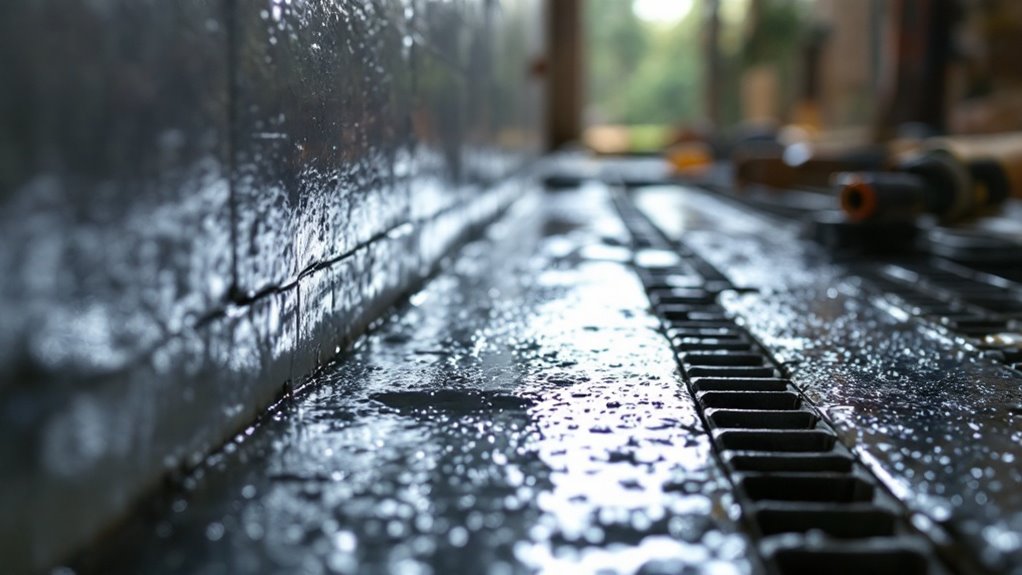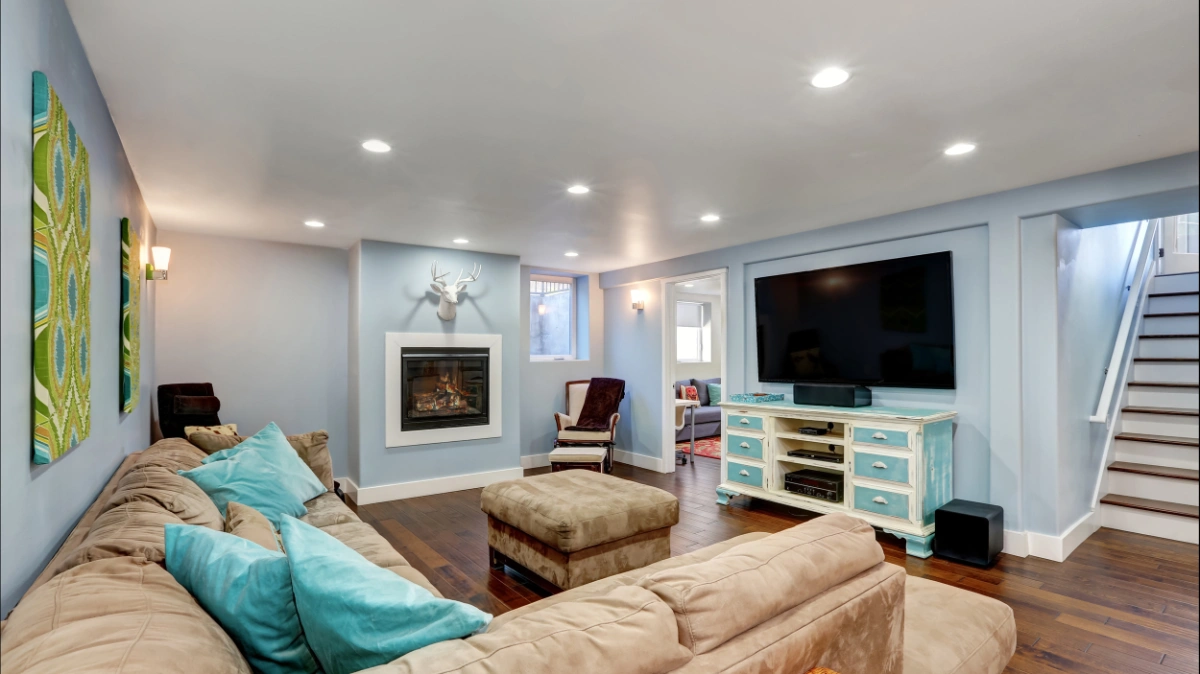Basement waterproofing is an essential process that prevents water from entering your below-grade space, avoiding costly damage and maintaining your home’s integrity.
It incorporates various methods like sealing, drainage systems, and crack repairs to keep moisture at bay.
Using both exterior and interior solutions, you can safeguard your basement effectively. Proper waterproofing not only protects your belongings but also enhances your living environment.
Explore how different strategies can work together for a drier, safer basement.
Key Takeaways
- Basement waterproofing prevents water entry in below-grade structures through sealing, draining, and reinforcing against moisture.
- It combines interior and exterior drainage systems with water-resistant coatings to protect against hydrostatic pressure.
- Common methods include concrete crack injection, waterproofing coatings, and proper drainage systems for effective moisture management.
- Regular inspections and maintenance are essential for ensuring the long-term effectiveness of waterproofing solutions.
- Effective waterproofing protects belongings, enhances indoor air quality, and safeguards property value by preventing structural damage and mold growth.
Definition and Importance of Basement Waterproofing
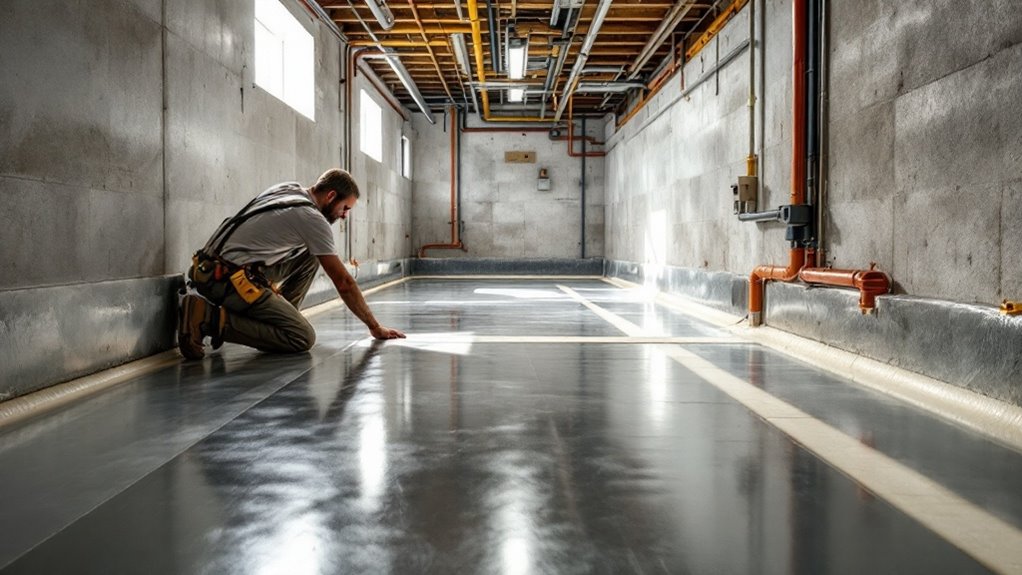
When it comes to protecting your home, basement waterproofing is essential for preventing water from entering below-grade structures. This involves techniques and materials designed to seal, drain, and reinforce your basement against moisture.
Effective waterproofing combines interior and exterior drainage systems with water-resistant coatings to manage both active leaks and passive moisture issues like humidity. Building codes often require these measures due to hydrostatic pressure risks. Additionally, professional waterproofing systems are recommended for long-term effectiveness against water intrusion.
Common Methods of Waterproofing
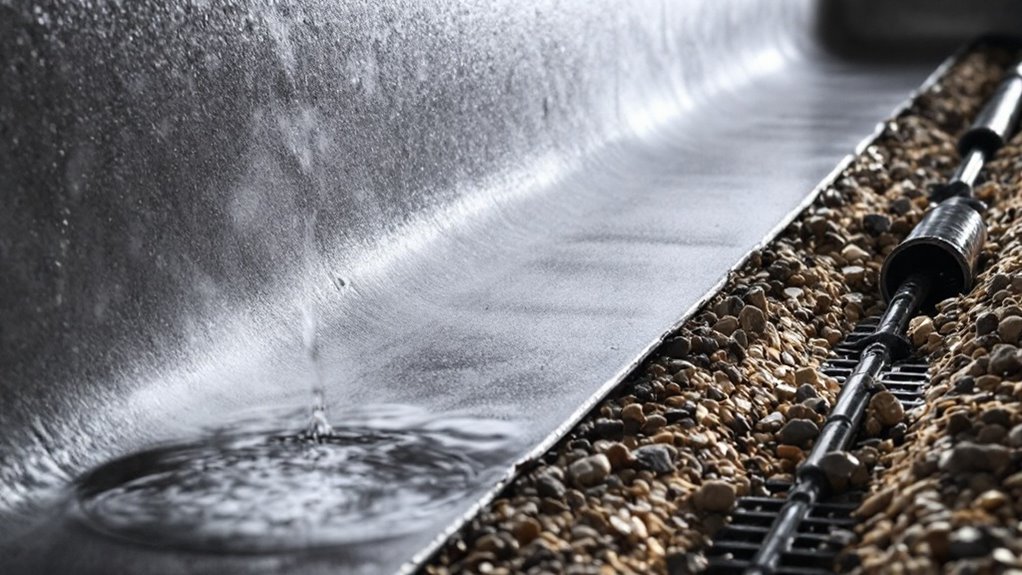
When it comes to waterproofing your basement, understanding the common methods is essential for effective protection.
You’ll find techniques like sealing and drainage systems that address both exterior and interior challenges.
Sealing Techniques Overview
To effectively protect your basement from water damage, understanding various sealing techniques is crucial. Here’s a quick overview of common methods:
| Technique | Description | Key Benefits |
|---|---|---|
| Concrete Crack Injection | Fills cracks with polyurethane/epoxy | Prevents water seepage |
| Exterior Waterproofing Coatings | Creates a moisture barrier on foundation walls | Protects against hydrostatic pressure |
| Silicate-Based Concrete Sealers | Chemically reacts to form a hardened layer | Limits mold growth |
| Waterproofing Paint | Adheres strongly to concrete surfaces | Provides a protective layer |
Choosing the right technique guarantees a dry, safe basement environment.
Basement Warning Signs?
Cracks, leaks, or musty smells could signal serious water damage ahead. Act now before minor issues become costly repairs.
- Class-A Licensed & Insured
- Full-Service Construction
- Trusted Local Family-Owned
Drainage Systems Explained
Understanding sealing techniques sets the foundation for a thorough approach to basement waterproofing, but drainage systems play an essential role in managing water intrusion.
Here are some common methods:
- Interior Perimeter French Drains: These systems capture water along the walls, directing it to a sump pump.
- Sump Pumps: Crucial for removing collected water, often with battery backups for reliability.
- Advanced Pipe Solutions: Newer materials and designs, like Fast Track systems, enhance flow rates.
- Maintenance Needs: Regular checks help prevent clogs and guarantee efficient drainage.
These drainage systems work together to create a waterproof basement environment.
Exterior vs. Interior Solutions
Choosing between exterior and interior waterproofing solutions is essential for effectively managing basement moisture.
Exterior methods, like coatings and dimple boards, create barriers to prevent water infiltration. These approaches typically require excavation but effectively stop water at the source.
In contrast, interior solutions, such as sealants and sump pumps, are less invasive and quicker to implement but may only provide temporary relief.
While exterior methods are ideal for finished basements, interior options are often more affordable.
Combining both strategies can enhance effectiveness, addressing various moisture challenges and ensuring a dry, healthy basement environment for your home.
Exterior Waterproofing Techniques
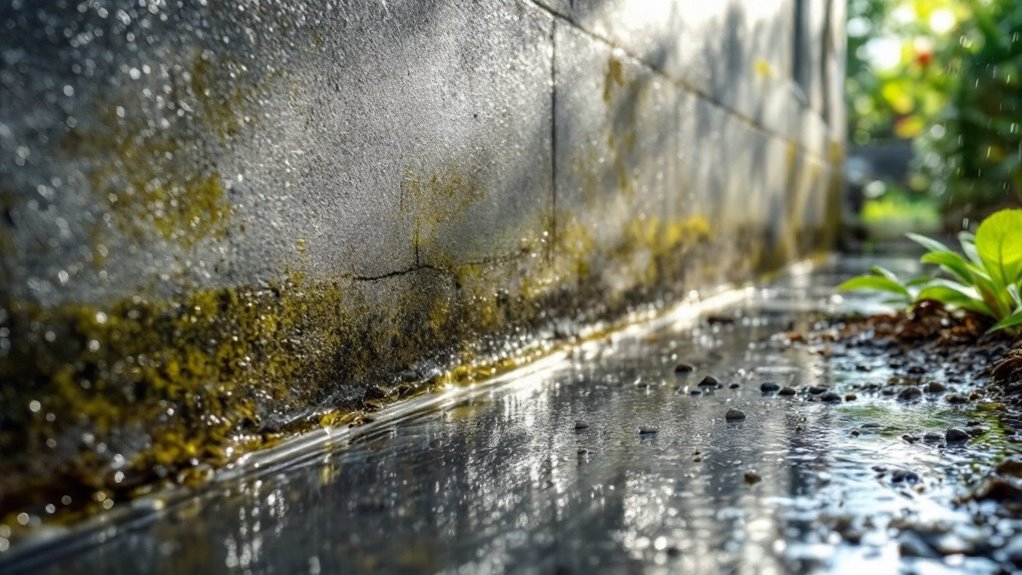
Exterior waterproofing techniques are vital for protecting your home from moisture intrusion and potential damage.
Here are some effective methods to take into account:
- Moisture barriers & membranes to block water infiltration.
- Drainage system upgrades like footer drains and French drains to redirect water.
- Slope adjustments around your home to prevent water accumulation.
- Regular maintenance of gutters and downspouts to guarantee proper flow.
Implementing these techniques can greatly enhance your home’s defense against water damage, assuring a dry and safe basement environment.
Don’t underestimate the importance of proper exterior waterproofing for long-lasting protection.
Interior Waterproofing Solutions
When tackling interior waterproofing, installing effective drainage systems is essential to managing water flow in your basement.
You’ll want to combine this with proper sealant application techniques to guarantee that moisture is kept at bay.
Understanding these strategies will help you create a dry, safe environment in your home.
Drainage System Installation
A well-designed drainage system is essential for effective interior waterproofing in your basement. Here’s what to take into account during installation:
- Excavate a trench deeper than your basement slab for a continuous perimeter drain.
- Install perforated PVC pipes at the trench base to collect groundwater efficiently.
- Create a gravel bed around the pipes for ideal filtration and drainage.
- Connect to a sump pump to evacuate collected water, ensuring proper discharge away from your foundation.
These steps help reduce hydrostatic pressure, keeping your basement dry and protected from moisture damage.
Sealant Application Techniques
After installing a reliable drainage system, the next step in ensuring a dry basement involves the careful application of sealants.
Start by cleaning surfaces thoroughly, removing dirt and mold, and ensuring they’re dry. Repair any cracks with hydraulic cement before sealing.
Choose the right sealant: waterproofing paints for walls or epoxy for larger cracks. Apply 1-2 coats for coverage, and use polyurethane foam for gaps.
Test porous areas for extra sealant needs. Remember to inspect and maintain your sealants every few years to keep your basement dry and protected from moisture intrusion.
Understanding Crack Repair Methods
Understanding the various crack repair methods is essential for maintaining the integrity of your basement. Here are some key approaches to evaluate:
- Assess crack size: Small cracks need monitoring, while dime-sized ones require professional attention.
- Choose the right materials: Use epoxy for dry cracks and polyurethane in damp conditions.
- Utilize injection methods: Install ports for controlled application of repair compounds.
- Reinforce structurally: Steel beams or carbon fiber strips can stabilize shifting walls.
The Role of Drainage Systems
When it comes to preventing water damage in your basement, effective drainage systems play an essential role. French drains are a common choice, with trenches along perimeter floors capturing excess water.
Interior drainage systems, like WaterGuard, use hidden channels to divert leaks to sump pumps, while hybrid drain tiles, such as Fast Track, reduce labor. Baseboard channels bond directly to floors, eliminating the need for trenching.
Though exterior systems can be effective, they typically carry higher costs and clogging risks. Choosing the right drainage system guarantees consistent water removal, protecting your basement from potential damage and maintaining a dry environment.
Benefits of Effective Basement Waterproofing
Effective basement waterproofing offers numerous benefits that go beyond just keeping your space dry.
By investing in waterproofing, you can enjoy:
- Protection for belongings and living areas from moisture damage
- A significant reduction in flood risk during heavy rainfall
- A healthier indoor environment, free from mold and allergens
- Enhanced structural integrity, preventing costly repairs
With these advantages, your basement becomes a safer and more usable space, while also preserving your home’s value.
A waterproofed basement transforms into a secure, functional area, safeguarding your home’s value for years to come.
You’ll not only protect your possessions but also improve your overall quality of life.
Embrace effective waterproofing to reap these essential benefits for your home.
Challenges in Waterproofing Basements
Even with the many benefits of effective basement waterproofing, homeowners often face significant challenges in keeping their basements dry and structurally sound. From cracks in foundations to hydrostatic pressure, these issues can seem overwhelming.
| Challenge | Cause | Impact |
|---|---|---|
| Cracks in Walls | Aging foundations | Water seepage |
| Hydrostatic Pressure | Poor drainage | Floor seepage |
| Material Deterioration | Outdated construction | Increased leak risk |
Addressing these challenges requires a proactive approach, including proper drainage systems and professional inspection. Ignoring them will only lead to more significant problems down the line.
Recap of what is basement waterproofing
To sum up, mastering basement waterproofing is like building a fortress against nature’s relentless forces.
By understanding various methods and addressing drainage issues, you can protect your home from costly water damage and mold growth. Investing in effective waterproofing not only enhances your property’s value but also gives you peace of mind.
So, don’t wait for leaks to turn into waterfalls—take proactive steps to safeguard your basement today and enjoy a dry, healthy living space for years to come.


